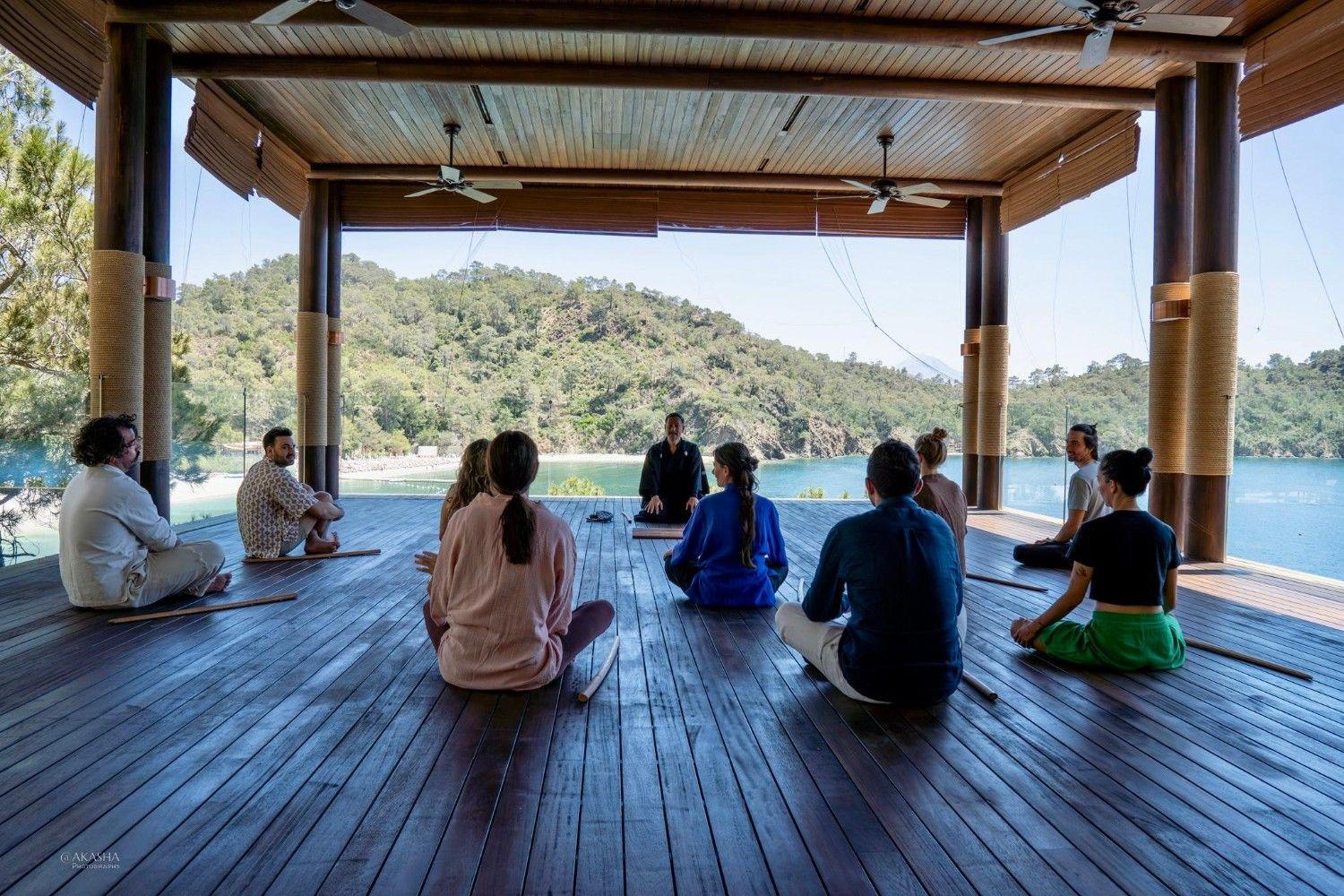
In the heart of an ancient forest by the Aegean Sea, Ahãma is not just a hotel — it is a soulful awakening where fire meets flavor and nature whispers through every bite.
We walk through the heart of a 20-hectare protected forest, among towering, healing liquidambar trees, and arrive at a pristine white beach. At the edge of the cove stands a minimalist, unobtrusive structure; in the center of the sand, a small restaurant; and scattered along the shore, wooden loungers. In defiance of today’s flamboyant notion of a “beach holiday,” Ahãma draws me in first and foremost with its serenity. After two and a half uninterrupted months of television shoots, I find myself in a place that feels like medicine for the soul. I have a deep fondness for places that “remind” me of what I value, how I feel and what truly defines me.
Set in Günlüklü Cove in Göcek, on a gentle slope opening slowly toward the sea, Ahãma is also Türkiye’s first Relais & Châteaux hotel nestled against the coastline. To be a member of Relais & Châteaux means more than offering luxury; it signifies a particular philosophy of life, a deep-rooted connection to local culture and a unique approach to hospitality. This membership represents a refined set of values far beyond the ordinary luxury category. And Ahãma is no exception. This is not just a place to stay and eat well; it is a space for transformation. Here, the concept of wellness is shaped through an intimate connection with water, sound and breath. The Sound Temple, designed by Mexican designer Héctor Esrawe, aligns the body through sound frequencies amid the stillness of the liquidambar forest. Qi Gong, Tai Chi, vocal activations and breathwork continue throughout the day. Paddleboard yoga at sunrise; ancient rituals performed around the fire at sunset…

Every moment on holiday is an invitation to a sensory rebirth; but for those of us who are devoted to the pleasures of the palate, it is essential that a part of this awakening is anchored at the table. A good meal is as captivating as the blue of the sea, as moving as the linen sheets in the room. And in hotels like Ahãma, it’s not just about taste — it becomes a narrative encompassing the spirit, nature, seasons and cultural memory of the region. Every detail the chef places on the plate forms an invisible bond between you and your surroundings. And at Ahãma, the person who helps establish that bond is Chef Mustafa Otar.
When one hears the name Mustafa Otar, the first thing that comes to mind is dishes prepared with theatrical fire techniques. At Ay, Ahama’s bold restaurant, fire lies at the very heart. Here, the dramatic core of the menu is undoubtedly fire. Dishes with strong personalities—kokoreç wrapped around sweetbread, crispy on the outside and soft inside; dry-aged fish; grilled lobster—are all cooked slowly over embers, with deep respect for time and patience. But don’t be fooled by these dazzling centerpieces; Ay’s true surprise lies in its more humble corners. For me, the silent stars of this kitchen are the meze. Each one is elevated to a new dimension with refined, stylized restraint.
Take, for example, the house-made bottarga… Lightly salted, with an almost creamy texture, it replaces the usual assertive flavor with a soft, silky marine note. When paired with butter infused with lakerda and served atop sourdough bread, it becomes even more delicious. In the fish charcuterie plate, fish prepared in four different techniques — pastrami, marinated, smoked and classic lakerda — go beyond technical showcases and reflect a culinary philosophy that seeks to understand the fish in all its forms. The fava arrives with a graceful freshness, diverging from the expected: topped with pine nuts, raisins and dill-dressed peas. The octopus, with a delightfully tender texture, is served over a chickpea stew. Lamb liver, paired with chimichurri, takes a bold step outside classic cuisine. The börek, baked over a wood fire with a rich filling of pastrami, leeks and cheese, is sliced lengthwise and drizzled with honey before serving
Ay and Ege Umi are open only for dinner. During the day, beach service is provided by Mezkla, a name familiar to those in Etiler. Once again, Mezkla has crafted a menu at Ahãma that perfectly suits the summer vibe. The taco varieties, lionfish ceviche and grilled sea bass in Mexico’s signature adobo sauce (made with cumin, oregano and tomato) are not to be missed. As for the chilled rice pudding made with frothed, full-fat coconut milk—I could eat it all summer long without a single complaint; that’s how much I loved it.
The crown jewel of Ahãma is Ege Umi. The name blends “Ege” (Aegean) and “umami,” reflecting their fusion of Aegean culinary memory with Japanese techniques. For the people of the Aegean, culinary memory is hidden in the scents of childhood, in the hands of grandmothers — most of whom were immigrants — in herbs dried by the wind and in olives ripened under the sun. Chef Otar brings this memory together with the disciplined techniques of Japanese cuisine. This isn’t a fusion; rather, it is a harmonious meeting of two ancient cultures — Aegean naturalness and Japanese culinary philosophy — at the same table. Ege Umi is overseen by Otar, but in the kitchen is his longtime friend from San Francisco, Mert Merkit. Ege Umi offers only a tasting menu, meaning you must surrender yourself entirely to the chef’s vision. Sea bass crudo with dashi jelly and citrus juice; meat tataki served with fruity kosho (a semi-fermented Japanese citrus sauce); precisely used seaweeds, misos and dashis…
In short, the pure and potent spirit of the Aegean is expressed in different tones across Ahãma’s restaurants. And once again, you come to realize that a good meal is the most honest and joyful relationship a person can have with nature.